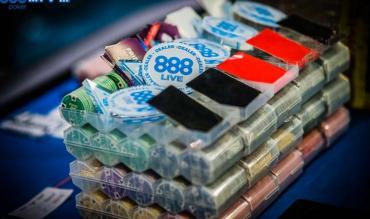A few years ago, players may have classified themselves as “maths players” or “feel players”, and if they had a good advantage in either one of these areas, they were more than likely a winning player. However, these days, with the ever-evolving skill edge of the general player pool, you must have both a good understanding of the mathematical concepts of poker as well as a solid, intuitive edge to stay afloat.
In this article, we shall elaborate on some of the more basic mathematical concepts that must be mastered initially, including many surrounding that of poker equity (pot equity) and fold equity.
TABLE OF CONTENTS
WHAT IS POKER EQUITY?
In poker, equity refers to the portion of the pot that is yours based on the likelihood (percentage) that you’ll win the hand at a certain point in time. (To put it another way, equity is the percentage of the time you should win a poker hand.)
As an example, if there is $1,000 in the pot, and you are currently an 80% favourite to win the hand, your pot equity is $800.
Subsequently, the general winning poker strategy you should follow when you have an equity advantage over your opponent is to bet for value.
This fact is due to two primary reasons:
- You gain equity in the pot, if your opponent calls. Imagine you bet $500 into a pot of $1,000 while having an 80% equity advantage. If your opponent chooses to call, you gain $400 in equity (80% x $500 call from your opponent) from the pot.
- You can prevent your opponent from realising their equity (by betting and allowing them an opportunity to fold). Imagine if your opponent has 20% equity and you can get them to fold after you bet. While you had 80% equity at the time, getting your opponent to fold ended up awarding you 100% of the equity in the pot.
NOTE: To play a balanced strategy and to maximise expected value (EV), it will not always be correct to bet when you have an equity advantage in a hand.
The tricky thing about poker is that a player’s equity will constantly be changing throughout a hand – from preflop to flop to turn to river. Therefore, you must continuously be assessing and reassessing your opponent’s likely hands and/or range and then correctly determining how your hand and/or range fairs against that to better deduce which course of action you should take.
Watch Kara Scott Interview with Ana Marquez on equity:
POKER EQUITY CHART
One of the ways you can increase your ability to calculate equity during a hand is to use and memorise equity charts for situations that you’ll frequently encounter in poker.
Here are some charts for such scenarios (both preflop and post-flop):
Common Preflop Scenarios
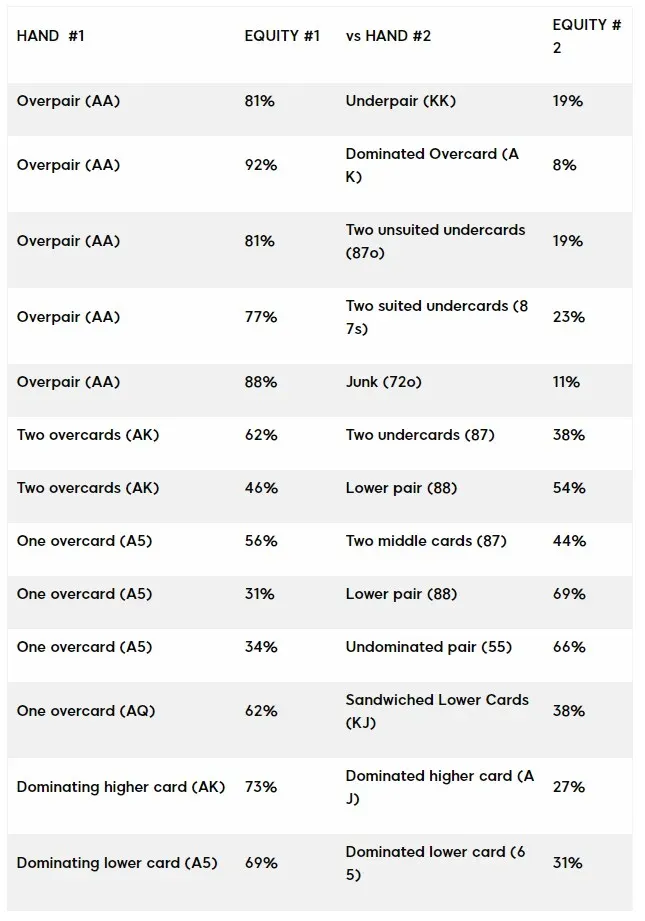
Common Post-flop Scenarios
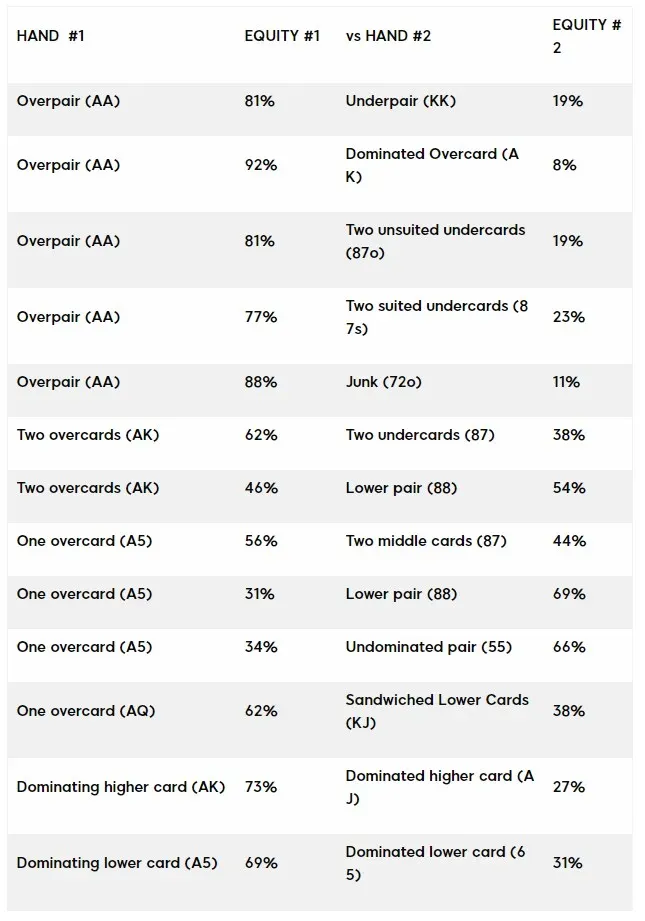
*OESD = Open Ended Straight Draw
HOW TO CALCULATE POKER EQUITY?
You might be wondering how these percentages are calculated. Quite frequently, computer programs (which we’ll discuss more in detail in the “Practice and Software” section below) are used to assist players initially in making such calculations.
After inputting the players’ hands and/or ranges, thousands of simulations are then quickly run by the software to find out how often each player will win the hand. Depending on which street action is on (preflop, flop, etc.), the number of different possible combinations can be numerous, meaning these simulations are very important to use in creating accurate estimates of player equities.
While it is almost impossible to make such complex calculations in-game, by both practising with software and studying charts like those provided above, a player’s guess at their equity can become much more accurate over time.
To help you make equity calculations specifically when you’re on a draw, one technique you can use is the “Rule of 2 and 4” (or 4 and 2). If you know how many “outs” you need to improve your hand and likely win, you should multiply this number by 4 with two cards to come (action on the flop) to find the approximate equity of beating your opponent. If there’s one card to come, you should multiply it by 2.
EXAMPLE: You have a flush draw on the flop, and you expect your opponent to be betting with many one-pair hands. If you think your hand will win if you hit your flush, you can use the “Rule of 2 and 4” to calculate your approximate equity, or chance of winning.
With 13 cards of each suit, 2 in your hand and 2 on the flop, this leaves 9 outs left that could help you hit your flush.
- 9 outs x 4 = 36% = the chance of hitting your flush after the flop (with 2 cards to come)
- 9 outs x 2 = 18% = the chance of hitting your flush after the turn (with 1 card to come)
Compare these equities to those listed in the more precise chart above and that they’re pretty close to being accurate!
POKER EQUITY: PRACTICE AND SOFTWARE
There are many different websites and software to help you better understand equities for hand vs hand, hand vs range, and range vs range situations.
For starters, you can use 888poker’s own Poker Odds Calculator if you ever need to run specific equities of hand vs. hand situations for any number of players.
After that come programs like PokerCruncher (for Mac) and Pokerstove and Equilab (for Windows), which can help you run all types of equity simulations, most prominently including hand ranges. (PokerTracker4 also has a built-in poker equity calculator component, too.)
Ultimately, the more experimenting you do with different simulations, the better you’ll get at determining whether you’re ahead or behind in any given situation.
NOTE: Remember, ranges will be different for different players. Be sure to experiment with your calculations using loose ranges and tight ranges (to accommodate such differences) from the various positions.
After you’ve practised, feel free to put your knowledge to the test with an incredible program called Uhlvar Equity (compatible with both Mac and Windows). You can create different randomised scenarios (preflop / post-flop / specific types of hands / etc.) where you must guess the equities of the two given hands.
While it is only available for hand vs hand calculations, use of this program will further increase your ability to predict equities during a hand accurately.
POKER FOLD EQUITY
Fold equity refers to the equity that a player can gain from a pot if his or her opponent folds (i.e. after they bet or raise).
Betting and raising help to deny your opponent the chance to realise their equity by giving them a chance to fold. In this same manner, poker bluffing and/or semi-bluffing can be profitable in certain instances: the additional equity a player gains in a hand by using fold equity.
Similarly, this is the reason why passive players are often losing players. The only chance they have of winning a pot is by fully realising their hand’s equity and not by means of additional fold equity.
Fold equity = (likelihood opponent folds) x
(gain in equity if opponent folds)
Using the formula above, let’s suppose a player with 30% equity makes a pot-sized bet and has an 80% chance of getting their opponent to fold a marginal made hand.
Their fold equity is then (80%)(70%) = 56%. Therefore, if they bet, their equity increases to 30% (actual equity) + 56% (fold equity) = 86%!
POKER HAND EQUITY
There are three things to consider when calculating the equity of your hand:
- Your opponent’s likely hands and/or hand range (based on position, tendencies, bet sizing, and other tells)
- The pot odds
- If you’re calling your opponent’s bet, consider both the expressed and/or implied odds you’re getting
- If you’re betting and want to lay a disadvantageous price to your opponent to continue with a draw and/or weaker hand, consider the proper bet size you should make so he wouldn’t be getting the right price to call (subsequently increasing your fold equity).
- Your hand’s equity relative to the previous two points.
POKER EQUITY: POKER STRATEGY
Your opponents may be more likely to fold to one or multiple bets or raises, if:
- They have represented a weak holding throughout the hand
- You have a significant range advantage
- They have a high “fold to cbet” statistic (check your HUD)
To calculate the expected value of a bet or raise you make (and taking into account fold equity), below is the formula you should use. (NOTE: It is often your arbitrary evaluation to determine the likelihood of your opponent folding during a hand when using the following formula. Reading your opponent and trying to determine the strength of their hand will help you guesstimate more accurately the chance that they will fold.)
EV = (percent villain folds)(pot won) +
(percent villain calls)((equity in pot) – amount put in pot)
For example, imagine a turn all-in scenario. There’s $300 already in the pot when you go all-in for $200. You’re semi-bluffing with a flush draw and an over-card (12 outs) for what you think is about 24% equity. You think your opponent will fold 80% of the time.
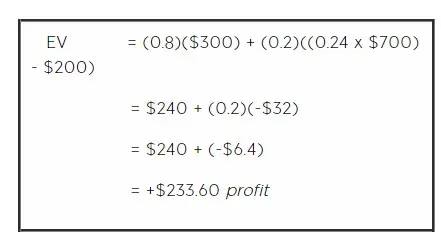
Therefore, your expected value of shoving for $200 here is +$233.60.
However, just to show how much worse it would be to shove here if you thought your opponent would call more frequently, let’s suppose they’ll call 80% of the time instead of 20%.
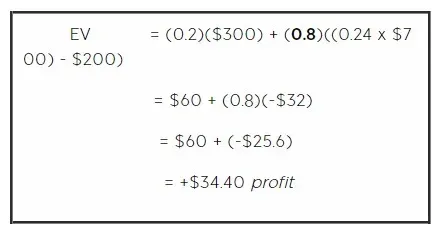
Therefore, while you’d still be profiting in the long-term by shoving here in this scenario, it will be far more profitable to do so if you think your opponent will fold a higher percentage of the time.
POKER EQUITY VS RANGE
The unfortunate thing about what we’ve been discussing regarding poker equity up until now is that you will likely never know for certain what your opponent’s specific hand is. That is why it is important to assign your opponent(s) with a range of poker hands and then calculate your equity against their range of hands.
However, if you have difficulties knowing exact equities of “hand versus hand” situations, then finding equities for “hand versus range” and “range versus range situations” will pretty much be impossible.
For this reason, training with equity calculators and practising with numerous different situations when away from the table is a must.
POKER EQUITY VS POT ODDS
Once you have an approximation as to the equity you have in a poker hand, you must assess the pot odds you’re getting to know if you can profitably continue (especially in such instances when you’re on a draw and looking to call).
NOTE: For a more in-depth discussion on pot odds and how to calculate them, read this article.)
In brief, you can use the aforementioned “Rule of 2 and 4” to calculate the approximate equity you have in a hand. Once you know this, you can relate it to the pot odds.
If there is $100 in the pot and the villain bets $50, you must call $50 to potentially win $150. Therefore, the pot odds you’re getting are 3 to 1, or 25%. To continue in this spot (based on expressed pot odds), you must have a hand with equity higher than 25%, if you want to show a long-term profit.
If you have equity less than this amount, though, you can still call sometimes if you think you have good enough implied odds – that is to say, money you can potentially win on future streets if you make your hand. Implied odds can make up the monetary difference for the correct expressed pot odds you needed to call.
In summary, an essential aspect of making profitable decisions at the poker table comes down to knowing if you have the correct poker odds vs equity in the hand to continue.
POKER EQUITY RANGE
For advanced players, while using equity and pot odds alone should greatly assist you in making better decisions at the table, you can and should also take into consideration the equity of your entire range versus that of your opponents.
If you have a range advantage (in terms of equity), you can frequently apply heavy aggression with your bluffs (as well as bluff more often), resulting in successfully taking down the pot with the help of fold equity.
Play with equity calculators to see how different ranges (tight / loose) from different positions (early / mid / late / blinds) stack up against each other on different boards.
SUMMARY
Understanding equity will help you realise when you’re likely ahead or behind in various situations, so that you can make better-educated decisions while playing regarding whether you should check, bet, raise, or fold.
Overall, betting when you have an equity advantage will increase your winnings in the long-term. Similarly, checking and folding when you have an equity disadvantage (and are not getting the right pot odds to continue) will help decrease your losses over time.
As a result, increasing your win rate all starts with understanding your poker equity during a hand.
